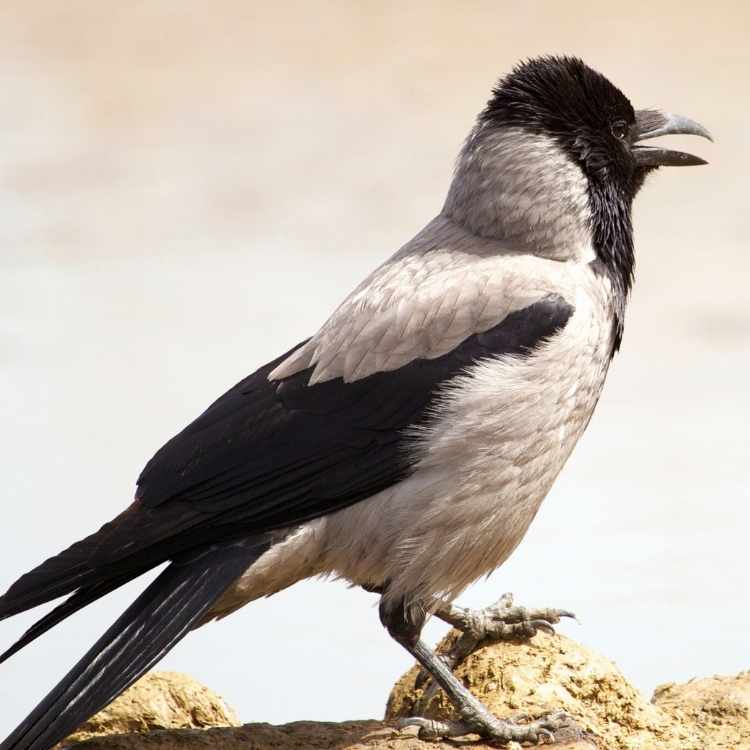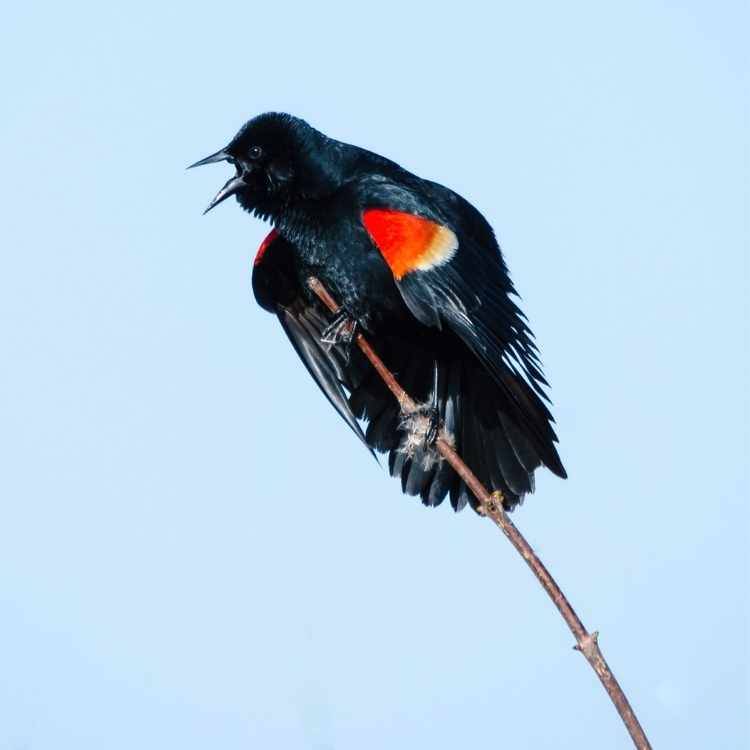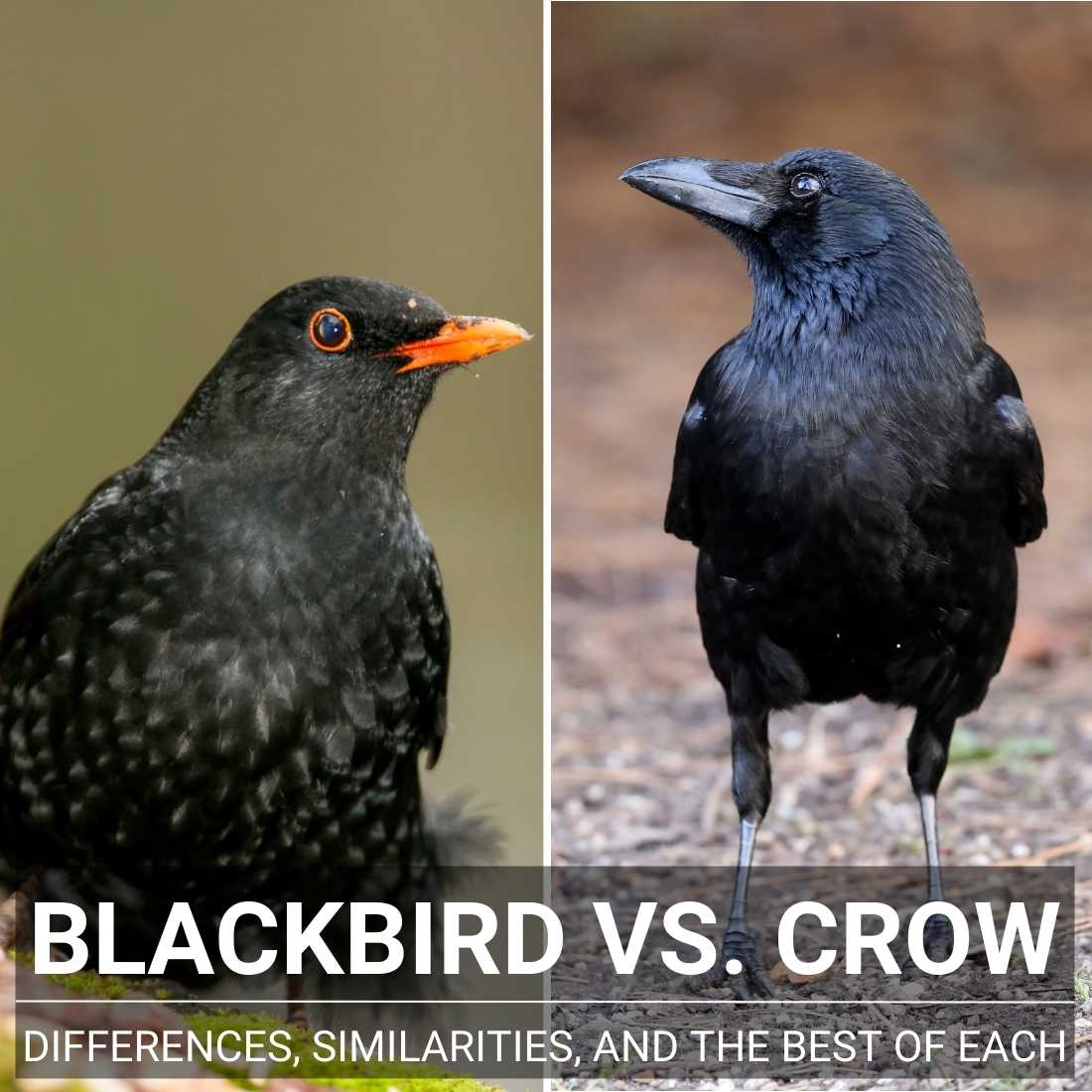There are many different types of birds in the world, and each one has its unique features and habits. In this blog post, we will be comparing the blackbird and crow.
Table of Contents
Both of these birds are common in North America, but they have some key differences in their behavior, diet, and habitat. Keep reading to learn more about these fascinating creatures! We will also provide some tips on how to identify the blackbird vs crow. So let’s get started!

Overview
| Blackbird | Crow |
|---|---|
| Blackbirds make a squee followed by a gurgle, both lasting nearly a second | Crows mainly give off a series of loud caws |
| Smaller than a crow | Over double the mass of a blackbird |
| Elliptical wing shape | Elliptical wing shape |
| Small beaks | Arched beaks |
| Tapered tails | Straight tails |
| Flies by beating their wings slowly and deeply. Usually flies as part of a large flock. | Flies steadily without gliding. Do not fly in straight lines. Usually flies alone or with a small flock. |
| Flock can consist of hundreds of individuals | Flocks consist of 2-8 individuals |
| Black feathers, with yellow eye-rings and yellow/orange beaks (males) | All black (American crows) Shiny with a blue sheen (Carrion crow) Grey and black (Hooded crow) |
| Cooperative breeders, winter brooding, anting | Migrates long distances, monogamous |
| Average lifespan 4 years (wild) | Average lifespan 7-8 years (American crow; wild) |
| Prefers rainforests, beach forests, and groves. Their preference for fruit and seeds often leads them to gardens. | Prefers open landscapes (for feeding) with nearby woods (for roosting) |
| Migrates 80 to 160 kilometers on average (common blackbirds) Migrates up to 1300 kilometers (red-winged blackbirds) | Migrates 500 kilometers on average (American crow) |
| Have 4 eggs in on the clutch | Have 3-9 eggs in on the clutch (American crow) |

Differences between Blackbird vs Crow
Physical Differences
Blackbirds are much smaller than crows, with the average mass of a European blackbird being only 102g compared to 400g for an American crow.
You’ll probably find the blackbird more appealing to the eye since it has a variety of colors ranging from yellow/orange beaks to a bright yellow eye-ring (males only).
The American crow is a bird that consists of black feathers (though if you like shiny things, you might like the fact that crow feathers sometimes give off a glossy look to them). And if you ever see a young crow’s brown feathers and think hmm perhaps not all crows are 100% black, don’t worry, they’ll turn black after their first molt.
Distribution and Habitat Differences
Crows prefer large open grasslands with nearby trees, where they can forage for food, breed, and roost.
On the other hand, Blackbirds tend to prefer a more urban environment than a rural one due to an abundance of food made by people. This doesn’t mean blackbirds don’t inhabit farmlands as well though, since they mainly build their nests in dense vegetation.
Behavior Differences
Crows are cooperative breeders, meaning some of the offspring won’t leave their nests and start their own families. Instead, they’ll remain at the nest to raise other young (known as helpers) that aren’t their own and defend the territory against predators.
Crows also engage in winter brooding, where they will gather in the hundreds or thousands in an area with large trees in the afternoon and all move to their permanent brooding site at night.
American crows, in particular, can also engage in a behavior called anting, which is when they stand on anthills and allow ants to climb onto them. They then rub the ants all over their feathers so that the crows can both ward off parasites, and get drunk from the formic acid released by the ants!
Crows are considered smart animals through their abilities to hunt and avoid capture.
Blackbirds, on the other hand, tend to migrate much further distances than crows, in part due to their need to escape disturbances like humans or dogs.
Blackbirds are monogamous and, although the female primarily builds the nest, both male and female will help raise the young.
Diet
Crows will eat almost anything smaller than them. This includes insects (plus their larvae), worms, fruits, grains, nuts, and even small rabbits! They sometimes also snatch eggs of smaller birds from their nests.
Blackbirds are a bit pickier in that they eat mostly fruits and grains.

Similarities between Blackbird vs Crow
If you’ve looked carefully at all the differences mentioned earlier, you can probably pick out a few things that are common to both blackbirds and crows. Other than their behavior, blackbirds and crows share similarities in almost every other category.
Blackbirds and crows are both, surprise surprise, mostly black in appearance. Other than their size difference and the minuscule colors found on blackbirds, it is very difficult to tell the two apart looking at them individually.
Both birds also enjoy similar habitats since both prefer using trees to build nests and forage food.
And finally, though crows have a larger palate than blackbirds, both enjoy the taste of fruits and grains. Also, because they both tend to inhabit urban areas, blackbirds and crows eat human-made food.
Are they the Same Bird?
Despite similar appearances, blackbirds and crows are not the same. Though both belong in the Passerine order, blackbirds and crows belong to the Turdidae and Corvidae families respectively.

Interesting Facts About Blackbirds
- Iceland is the only European country where blackbirds don’t breed, though some have been observed to migrate there.
- Blackbirds usually begin singing at the end of January or the beginning of February.
- Their singing usually lasts until the summer, during which they’ll mainly stop singing by mid-July.
- Blackbirds love to sing after the rain has stopped.
- Blackbirds were introduced to the US in the 19th century but failed to be sustained, hence they were seen primarily in Europe and the Oceania region, where they were successfully introduced.
- Blackbird calls and sounds: https://www.youtube.com/watch?v=l3yAR4_xr9g
- Read more about the blackbird symbolism and the red-winged blackbird meaning
- We have compared the blackbird to more birds: Grackle vs Blackbird – What Are the Differences?
Interesting Facts About Crows
- Crows are highly adaptable in that they will use methods such as using bread as bait to catch fish or secretly follow animals to steal their prey.
- Some crows can fashion their tools from branches or twigs to catch insects from small crevices.
- Crows are known to hold “funerals” for recently deceased individuals. They may keep a vigil for the fallen bird for several days.
- Crows can remember faces and even relay that information to other fellow crows.
- Crows can lead “double lives”, where they split their time between their families and a flock. Hence, although crows generally have monogamous relationships, a female crow’s offspring could’ve been fathered by several male crows.
- Crow calls and sounds: https://www.youtube.com/watch?v=eM4E9enGqRc
- We compared to crow also to: Grackle Vs Crow and Owl vs Crow
- Read also about the crow: crow symbolism, finding a dead crow, Crows in Mythology, Crow Feather Meaning.
Field Identification Tips
Blackbird
Male blackbirds are unmistakable, for their yellow bill and yellow ring around the eye are easily identifiable. Females are a dark brown color, with streaking on the chest and throat. They can be easily found in parks, gardens, and grasslands, often listening for earthworms or feeding on insects and berries.
Crow
Crows are much larger than blackbirds, with long legs and thick necks. Unlike blackbirds, crows are black all the way (including the legs and bill) except when they molt, in which their old feathers can appear brown. Crows are more commonly found in open fields, woodlands, and forests, but may also be seen in urban areas such as lawns and parking lots.
Final Verdict
Blackbirds and crows have adapted more and more to urban environments. If you happen to live in Europe or Australia, be sure to leave some apples or berries in your garden and you’ll surely be able to see for yourself!


I really enjoyed reading this.
Sharon, thank you so much for taking the time to read my blog post! I’m glad to hear that you enjoyed it. If you have any further thoughts or feedback, please feel free to share them. Thanks again for your kind words!